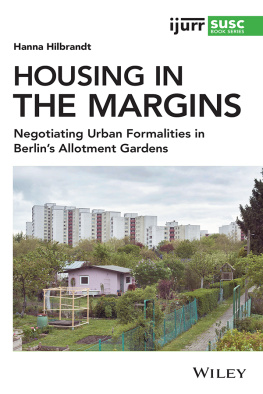Multi-Unit Housing in Urban Cities
From 1800 to Present Day
This book investigates the development of multi-unit housing typologies that were predominant in a particular city from the 1800s to the present day. It emphasises the importance of understanding the direct connection between housing and dwelling in the context of a city, and the manner in which the city is an instructional indication of how a housing typology is embodied.
The case studies presented offer an insight into why a certain housing type flourished in a specific city and the variety span across cities in the world where distinct housing types have prevailed. It also pursues how housing types developed, evolved, and helped define the city, looks into how dwellers inhabited their dwellings, and analyses how the housing typologies correlate in a contemporary context. The typologies studied are back-to-backs in Birmingham; tenements in London; Haussmann Apartment in Paris; tenements in New York; tong lau in Hong Kong; perimeter block, linear block, and block-edge in Berlin; perimeter block and solitaire in Amsterdam; space-enclosing structure in Beijing; micro house in Tokyo; and high-rise in Toronto.
Katy Chey is an architect living, working, and teaching in Toronto. She lives in a multi-unit housing dwelling in the city.
Multi-Unit Housing in Urban Cities
From 1800 to Present Day
Katy Chey
First published 2018
by Routledge
711 Third Avenue, New York, NY 10017
and by Routledge
2 Park Square, Milton Park, Abingdon, Oxon, OX14 4RN
Routledge is an imprint of the Taylor & Francis Group, an informa business
2018 Taylor & Francis
The right of Katy Chey to be identified as author of this work has been asserted by her in accordance with sections 77 and 78 of the Copyright, Designs and Patents Act 1988.
All rights reserved. No part of this book may be reprinted or reproduced or utilised in any form or by any electronic, mechanical, or other means, now known or hereafter invented, including photocopying and recording, or in any information storage or retrieval system, without permission in writing from the publishers.
Trademark notice : Product or corporate names may be trademarks or registered trademarks, and are used only for identification and explanation without intent to infringe.
Every effort has been made to contact and acknowledge copyright holders, but the author and publisher would be pleased to have any errors or omissions brought to their attention so that corrections may be published at a later printing.
Library of Congress Cataloging-in-Publication Data
A catalog record for this book has been requested
ISBN: 978-1-138-18994-2 (hbk)
ISBN: 978-1-138-18995-9 (pbk)
ISBN: 978-1-315-64135-5 (ebk)
Typeset in Helvetica Light
by Florence Production Ltd, Stoodleigh, Devon, UK
Contents
by Hans Ibelings
Guide
A pit bull on the Upper West Side noses open a refrigerator door. A Pomeranian obsessively rearranges her bedding. A rabbit in Greenpoint, Brooklyn, waits for his nightly bowl of oats. A bulldog in the East Village makes passionate love to a pillow.
This is how an article begins in The New York Times, published in the summer of 2016. It describes how pets live their domestic lives, unaware of being monitored by cameras, while their human companions are away. Most of the time there is not a lot going on. It turns out that pets sleep a lot when there is nobody around.
What pets do when they are home alone doesnt differ much from what humans do when they dwell: eating, cleaning, idling, having sex, sleeping. And just as with the secret life of pets, most of the time the human act of dwelling passes unnoticed. Even to dwellers themselves, who happen to dwell almost unselfconsciously. Precisely because it is so common to dwell, it is extremely hard to say what it is and how dwellers do it.
Most of the time, the act of dwelling exists in the domain of the infra-ordinary, as French writer Georges Perec has called it in a short essay written in 1973. The infra-ordinary is here, right in front of us, but we are unable to see it, unless, as Perec stated we start,
to question that which seems to have ceased forever to astonish us. We live, true, we breathe, true; we walk, we open doors, we go down staircases, we sit at a table in order to eat, we lie down on a bed in order to sleep. How? Where? When? Why?
The same question applies to the dwelling itself. We can easily see the extraordinary, aspirational forms of habitation for a happy few, when they are published in lifestyle and architectural magazines for instance, but rarely can we discern the multitude of quotidian forms of living. How, where, when, and why we dwell often remains opaque. We just do it.
With more than half of the worlds population living in urban environments, dwelling is deeply entangled with the city, a phenomenon which is often as hard to fathom as dwelling, and dwellings. The complexity of the city was succinctly defined by Egyptian architect Hassan Fathy during a conference in Persepolis back in 1974, when he said that a city is not the stone and bricks of which its buildings are made. Its a million of acts that go into its making and the millions of acts that go on within it at every moment. Many of those million of acts are related to housing, which, according to unsubstantiated by intuitively probable estimates, makes up around three quarters of cities.
As Fathys statement elucidates, it is difficult to comprehend dwelling, dwellings, or the city in their entirety. Katy Cheys foray into the universe of urban housing is an ambitious attempt to deepen our understanding of what living in the cities means, and how in different times and places, the question of the big number of housing has been addressed and articulated in different building typologies, and how they have shaped the city.
Cheys capita selecta cover two centuries and a huge, and culturally diverse, territory which includes cities in Western Europe, North America, and Eastern Asia. The ten case studies in her book offer, in their breadth and depth, a wealth of knowledge and many great insights, yet they have an intriguing side effect, at least for this reader: the humbling realisation how many of the acts that go into the making of cities, even the ones I am familiar with, remain infra-ordinarily invisible. Not to mention the thousands of other cities I am not familiar with, and all their millions of acts that that go in their making and all the lives that take place in them. In that sense this book is as illuminating for what it contains, and for what it doesnt.
Hans Ibelings
Hans Ibelings is an architecture critic and historian. He is the editor and publisher of The Architecture Observer and author of numerous books on architecture and housing.
Many people have contributed to the content of this book and I would like to take this opportunity to acknowledge them. I would like to first thank Brian Boigon, then Director of Bachelor of Arts and Architectural Studies Program at the University of Toronto, John H. Daniels Faculty of Architecture, Landscape and Design, for giving me the opportunity to teach the housing course. I need to thank Richard Sommer, Dean of the Daniels Faculty for his conversation, enthusiasm and support for my project. I would like to sincerely thank the multitude of colleagues who have shared their knowledge of my subject in the form of suggestions, advice, and feedback, and I have to extend a special thanks to Hans Ibelings for his insightful foreword. I would like to express my gratitude to my Routledge editors. To Wendy Fuller, then Commissioning Editor Architecture, for being interested in my topic and believing that it could be brought to a wider audience; Grace Harrison, then Editorial Assistant, for her assistance and guidance; and Katharine Maller, Commissioning Editor Architecture, for going above and beyond her role and coming to my rescue. I need to thank Zainab Abbasi, Bohden Tymchuk, Jiawen (Carmen) Lin, Xinting Fan, and Roseanne Imee Reyes Barbachano, my student assistants who drew and drew and drew some more. To friends and family who afforded me the use of their photos. To my parents, for simply everything. And finally, my deepest appreciation goes to Javier Viteri. There are not enough pages to describe all the support, encouragement, and patience provided unconditionally by him for this project. He is my house and home, and this book is to, for and because of him.








